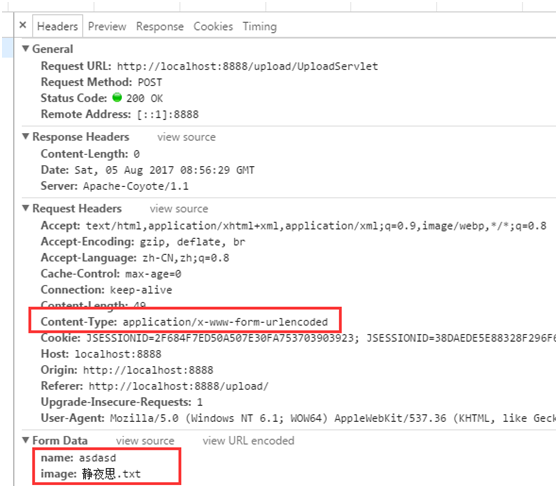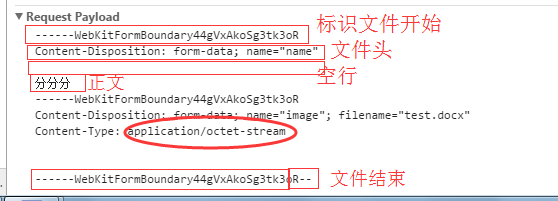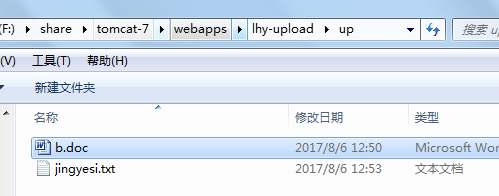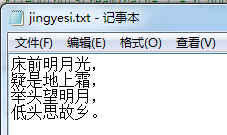基于java文件上传-原始的Servlet方式
前言:干了这几个项目,也做过几次文件上传下载,要么是copy项目以前的代码,要么是百度的,虽然做出来了,但学习一下原理弄透彻还是很有必要的。刚出去转了一圈看周围有没有租房的,在北京出去找房子是心里感觉最不爽的时候,没有归属感,房租还不便宜,RT,不能好高骛远,还是脚踏实地一点一点学技术吧,终将有一日,工资会涨的。
java文件上传
传统的文件上传,不用jquery插件的话,就是用form表单提交,项目里用过uploadify,可以异步上传文件,原理我也没研究。现在说传统的form表单上传文件。
文件上传核心:
用<input type=”file”/> 来声明一个文件域。样式如 文件:_____ <浏览>.
必须使用post方式提交表单。
必须设置表单的类型为multipart/form-data.是设置这个表单传递的不是key=value值。传递的是字节码.
新建web项目:
jsp form表单:enctype(编码类型)的默认值就是 application/x-www-form-urlencoded

 浏览器查看 http报文:
浏览器查看 http报文: 主要参数:Accept:text/html,application/xhtml+xml,application/xml;q=0.9,image/webp,*/*;q=0.8 接收服务器返回的类型,*/*表示所有。Referer:http://localhost:8888/upload/ 来自哪个网站Accept-Language:zh-CN,zh;q=0.8 :请求回应中首选的语言为简体中文Accept-Encoding:gzip, deflate, br支持的压缩格式User-Agent:Mozilla/5.0 (Windows NT 6.1; WOW64) AppleWebKit/537.36 (KHTML, like Gecko) Chrome/56.0.2924.87 Safari/537.36 用户浏览器类型Host:localhost:8888 主机地址Connection:keep-alive 报文发送完毕后仍然保持连接Cache-Contrp: max-age=0 缓存Content-Length: 41 41字节对文件上传来说,重要的参数是:Content-Type: application/x-www-form-urlencoded这个参数只有post请求才有,默认就是application/x-www-from-urlencoded ,Content-type表示正文类型,get方式没有正文,因为参数在url里。在Servlet里可以用request对象取到Content-type:request.getHeader("Content-type"); 默认的值为 application/x-www-form-urlencoded,如果是get请求,则 request.getHeader("Content-type");为null。下图是get请求时的http头信息:
主要参数:Accept:text/html,application/xhtml+xml,application/xml;q=0.9,image/webp,*/*;q=0.8 接收服务器返回的类型,*/*表示所有。Referer:http://localhost:8888/upload/ 来自哪个网站Accept-Language:zh-CN,zh;q=0.8 :请求回应中首选的语言为简体中文Accept-Encoding:gzip, deflate, br支持的压缩格式User-Agent:Mozilla/5.0 (Windows NT 6.1; WOW64) AppleWebKit/537.36 (KHTML, like Gecko) Chrome/56.0.2924.87 Safari/537.36 用户浏览器类型Host:localhost:8888 主机地址Connection:keep-alive 报文发送完毕后仍然保持连接Cache-Contrp: max-age=0 缓存Content-Length: 41 41字节对文件上传来说,重要的参数是:Content-Type: application/x-www-form-urlencoded这个参数只有post请求才有,默认就是application/x-www-from-urlencoded ,Content-type表示正文类型,get方式没有正文,因为参数在url里。在Servlet里可以用request对象取到Content-type:request.getHeader("Content-type"); 默认的值为 application/x-www-form-urlencoded,如果是get请求,则 request.getHeader("Content-type");为null。下图是get请求时的http头信息:
文件上传,必须设置enctype="multipart/form-data"
from表单: 上传一个word:
上传一个word: 此时的http消息: Content-Type:multipart/form-data; boundary=----WebKitFormBou ndarywYwQ3v1NemO0bPfM 。
此时的http消息: Content-Type:multipart/form-data; boundary=----WebKitFormBou ndarywYwQ3v1NemO0bPfM 。
其中的 boundary=----WebKitFormBoundary44gVxAkoSg3tk3oR 指的是文件上传的分隔符。
 看请求的报文: boundry=xxxxx 标识文件开始,也有文件头,说的是上传的数据的类型,第一个input 是text类型,第二个是二进制,content-type 是application/octet-stream 表示 二进制流。上传图片,Content-Type: image/jpeg,上传文本,Content-Type: text/plain。
看请求的报文: boundry=xxxxx 标识文件开始,也有文件头,说的是上传的数据的类型,第一个input 是text类型,第二个是二进制,content-type 是application/octet-stream 表示 二进制流。上传图片,Content-Type: image/jpeg,上传文本,Content-Type: text/plain。 二进制流的接收:当表单类型是post类型,切enctype="multipart/form-data",则所有的数据都是以二进制流的形式向服务器上传,所以request.getParameter("xxx") 永远为null,只能通过req.getInputStream(); 获取正文。上传一个txt:
二进制流的接收:当表单类型是post类型,切enctype="multipart/form-data",则所有的数据都是以二进制流的形式向服务器上传,所以request.getParameter("xxx") 永远为null,只能通过req.getInputStream(); 获取正文。上传一个txt: Servlet:
Servlet:
package com.lhy.upload;
import java.io.BufferedReader;
import java.io.FileOutputStream;
import java.io.IOException;
import java.io.InputStream;
import java.io.InputStreamReader;
import java.io.OutputStream;
import java.io.PrintWriter;
import javax.servlet.ServletException;
import javax.servlet.annotation.WebServlet;
import javax.servlet.http.HttpServlet;
import javax.servlet.http.HttpServletRequest;
import javax.servlet.http.HttpServletResponse;
/**
*
* @author Administrator
*
*/
@WebServlet(name="UploadServlet",urlPatterns="/UploadServlet")
public class UploadServlet extends HttpServlet{
@Override
protected void doGet(HttpServletRequest req, HttpServletResponse resp)
throws ServletException, IOException {
// this.doPost(req, resp);
}
@Override
protected void doPost(HttpServletRequest req, HttpServletResponse resp)
throws ServletException, IOException {
req.setCharacterEncoding("UTF-8");
String contentType = req.getHeader("Content-type");
System.out.println("contentType: "+contentType);
String name = req.getParameter("name");
System.out.println(name);//null
InputStream is = req.getInputStream();
// ------WebKitFormBoundaryG0ULv7eVfQ1K2PBA
// Content-Disposition: form-data; name="image"; filename="静夜思.txt"
// Content-Type: text/plain
//
//
// ------WebKitFormBoundaryG0ULv7eVfQ1K2PBA--
BufferedReader br = new BufferedReader(new InputStreamReader(is));
String firstLine = br.readLine();//第一行,分隔符
String fileName = br.readLine();
// Content-Disposition: form-data; name="image"; filename="jingyesi.txt"
fileName = fileName.substring(fileName.lastIndexOf("=")+2,fileName.length()-1);
br.readLine();
br.readLine();
String data = null;
//获取当前项目的运行路径
String path = getServletContext().getRealPath("/up");
PrintWriter pw = new PrintWriter(path+"/"+fileName);
while((data = br.readLine()) != null){
if(data.equals(firstLine+"--")){
break ; //读到了文件尾
}
pw.println(data);
}
pw.flush();
pw.close();
is.close();
/* FileOutputStream fos = new FileOutputStream(path+"/"+"b.doc");
// byte[] b = new byte[1024];
int len = 0;
while((len = is.read()) != -1){
fos.write(len);
}
fos.flush();
fos.close();
is.close();*/
}
}
项目里:


例子只是读取了txt,其他的二进制需要使用inputStream读取。
以上这篇基于java文件上传-原始的Servlet方式就是小编分享给大家的全部内容了,希望能给大家一个参考,也希望大家多多支持我们。

